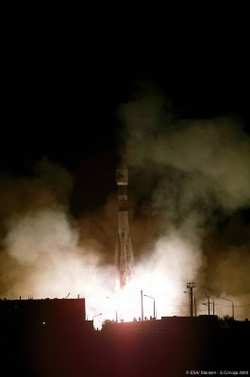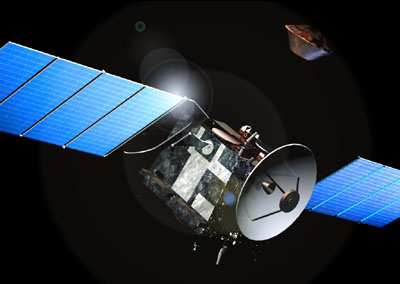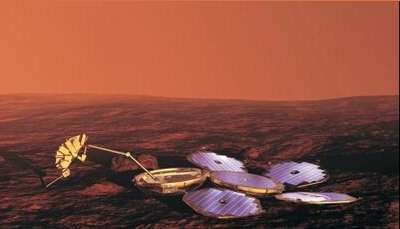European Venture On Way to Red Planet
 The European Mars Express space probe has been
placed successfully in a trajectory that will take it beyond the
terrestrial environment and on the way to Mars; it will arrive in
late December.
The European Mars Express space probe has been
placed successfully in a trajectory that will take it beyond the
terrestrial environment and on the way to Mars; it will arrive in
late December.
This first European Space Agency probe to head for another
planet will enter an orbit around Mars, whence it will perform
detailed studies of the planet’s surface, its subsurface
structures and its atmosphere. It will also deploy Beagle 2, a
small autonomous station which will land on the planet, studying
its surface and looking for possible signs of life, past or
present.
The probe, weighing in at 1,120 kg (about 2500 pounds), was
built on ESA’s behalf by a European team led by Astrium. It
set out on its journey to Mars aboard a Soyuz-Fregat launcher,
under Starsem operational management. The launcher lifted off from
Baïkonur, in Kazakhstan, Monday night, a quarter before
midnight, local time (17:45 Zulu). An interim orbit around the
Earth was reached following a first firing of the Fregat upper
stage. One hour and thirty-two minutes later, the probe was
injected into its interplanetary orbit.
Contact with Mars Express was established by ESOC
 "Europe is on its way to Mars to stake its claim
in the most detailed and complete exploration ever done of the Red
Planet. We can be very proud of this and of the speed with which
have achieved this goal," said David Southwood, ESA's Director of
Science, after witnessing the launch from Baikonur. Contact with
Mars Express has been established by ESOC, ESA’s satellite
control center, located in Darmstadt, Germany.
"Europe is on its way to Mars to stake its claim
in the most detailed and complete exploration ever done of the Red
Planet. We can be very proud of this and of the speed with which
have achieved this goal," said David Southwood, ESA's Director of
Science, after witnessing the launch from Baikonur. Contact with
Mars Express has been established by ESOC, ESA’s satellite
control center, located in Darmstadt, Germany.
The probe is pointing correctly towards the Sun and has deployed
its solar panels. All on-board systems are, the agency says,
"operating faultlessly." On Wednesday, the probe will perform a
corrective maneuver that will place it in a Mars-bound trajectory,
while the Fregat stage, trailing behind, will vanish into space
– there will be no risk of its crashing into (contaminating)
the Red Planet.
Mars Express will then travel away from Earth at a speed
exceeding 30 km/s (3 km/s in relation to the Earth), on a six-month
and 400-million kilometer journey through the solar system. Once
all payload operations have been checked out, the probe will be
largely deactivated. During this period, the spacecraft will
contact Earth only once a day. Mid-journey correction of its
trajectory is scheduled for September.

Beagle 2 lander leaving the Mars Express orbiter
Following reactivation of its systems at the end of November,
Mars Express will get ready to release Beagle 2. The 60 kg
capsule containing the tiny lander does not incorporate its own
propulsion and steering system and will be released into a
collision trajectory with Mars, five days before Christmas. It will
enter the Martian atmosphere on Christmas day.
As it descends, the lander will be protected in the first
instance by a heat shield; two parachutes will then open to provide
further deceleration. With its weight down to 30 kg at most, it
will land in an equatorial region known as Isidis Planitia. Three
airbags will soften the final impact. This crucial phase in the
mission will last just ten minutes, from entry into the atmosphere
to landing.

Meanwhile, the Mars Express probe itself will have performed a
series of maneuvers through to a capture orbit. At this point its
main motor will fire, providing the deceleration needed to acquire
a highly-elliptical transition orbit. Attaining the final
operational orbit will call for four more firings. This 7.5 hour
quasi-polar orbit will take the probe to within 250 km of the
planet.
Having landed on Mars, Beagle 2 (named after HMS
Beagle, on which Charles Darwin voyaged round the world) will
deploy its solar panels and the payload adjustable workbench
("PAW"), a set of instruments (two cameras, a microscope and two
spectrometers) mounted on the end of a robot arm.
It will proceed to explore its new environment, gathering
geological and mineralogical data that should, for the first time,
allow rock samples to be dated with reasonable accuracy. Using a
grinder and corer, and the "mole" (a wire-guided mini-robot able to
borrow its way under rocks and dig the ground to a depth of six and
a half feet), samples will be collected and then examined in the
GAP automated mini-laboratory, equipped with 12 furnaces and a mass
spectrometer. The spectrometer will have the job of detecting
possible signs of life and dating rock samples.

The Mars Express orbiter will carry out a detailed investigation
of the planet, pointing its instruments at Mars for between
half-an-hour and an hour per orbit and then, for the remainder of
the time, at Earth to relay the information collected in this way
and the data transmitted by Beagle 2.
The orbiter’s seven on-board instruments are expected to
provide considerable information about the structure and evolution
of Mars. A very high resolution stereo camera, the HRSC, will
perform comprehensive mapping of the planet at 10 meters resolution
and will even be capable of photographing some areas to a precision
of barely 2 meters. The OMEGA spectrometer will draw up the first
mineralogical map of the planet to 100-meter precision.
The orbiter mission should last at least one Martian year (687
days), while Beagle 2 is expected to operate on the
planet’s surface for 180 days. This first European mission to
Mars incorporates some of the objectives of the Euro-Russian Mars
96 mission, which came to grief when the Proton launcher failed.
And indeed a Russian partner is cooperating on each of the
orbiter’s instruments.
 Mars
Express forms part of an international Mars exploration program,
featuring also the US probes Mars Surveyor and Mars Odyssey, the
two Mars Exploration Rovers and the Japanese probe Nozomi. Mars
Express may perhaps, within this partnership, relay data from the
NASA rovers while Mars Odyssey may, if required, relay data from
Beagle 2.
Mars
Express forms part of an international Mars exploration program,
featuring also the US probes Mars Surveyor and Mars Odyssey, the
two Mars Exploration Rovers and the Japanese probe Nozomi. Mars
Express may perhaps, within this partnership, relay data from the
NASA rovers while Mars Odyssey may, if required, relay data from
Beagle 2.
The mission’s scientific goals are of outstanding
importance. Mars Express will, it is hoped, supply answers to the
many questions raised by earlier missions – questions
concerning the planet’s evolution, the history of its
internal activity, the presence of water below its surface, the
possibility that Mars may at one time have been covered by oceans
and thus have offered an environment conducive to the emergence of
some form of life, and even the possibility that life may still be
present, somewhere in putative subterranean aquifers. In addition,
the lander's doing direct analysis of the soil and the environment
comprises a truly unique mission.
Next: Venus, 2005.
 ANN's Daily Aero-Linx (04.16.24)
ANN's Daily Aero-Linx (04.16.24) Aero-News: Quote of the Day (04.16.24)
Aero-News: Quote of the Day (04.16.24) Airborne 04.10.24: SnF24!, A50 Heritage Reveal, HeliCycle!, Montaer MC-01
Airborne 04.10.24: SnF24!, A50 Heritage Reveal, HeliCycle!, Montaer MC-01 Airborne 04.12.24: SnF24!, G100UL Is Here, Holy Micro, Plane Tags
Airborne 04.12.24: SnF24!, G100UL Is Here, Holy Micro, Plane Tags Airborne-Flight Training 04.17.24: Feds Need Controllers, Spirit Delay, Redbird
Airborne-Flight Training 04.17.24: Feds Need Controllers, Spirit Delay, Redbird








